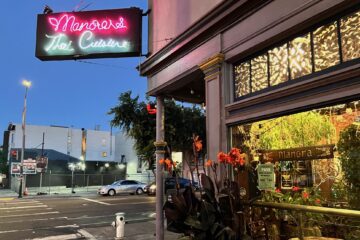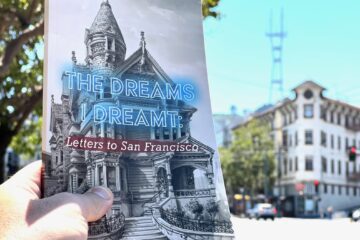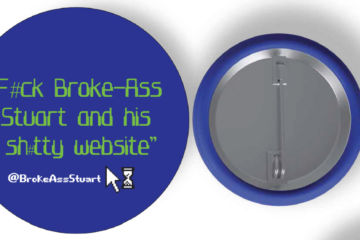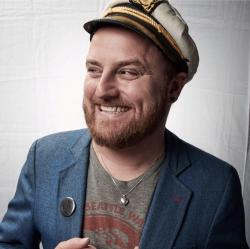There is No San Francisco Without San Francisco
I wrote this essay during one of the deepest parts of the pandemic. It’s from the upcoming collection The End of the Golden Gate: Writers on Loving and (Sometimes) Leaving San Francisco. The book is REALLY good and includes such luminaries as Margaret Cho, W. Kamau Bell, Michelle Tea, John Law, and more! You can preorder it right here.
It felt like moving trucks were parked on every block in town. There was a low hum of activity as friends, frenemies, lovers, ex-lovers, sometimes lovers, parents, stepparents, drag parents, and day laborers hired from in front of the U-Haul place on Bryant Street, all carried furniture out of buildings throughout the city. It was July 1, 2020, five months into the COVID crisis, and San Francisco was hemorrhaging residents. Apparently, all it took was a literal fucking pandemic for thousands to realize they’d finally had enough of this place.
All this time we’d been saying, “Just wait till there’s a big earthquake and watch all these people scurry back to Ohio or Wisconsin or wherever the hell they came from.” Little did we know that something far more microscopic would actually be the thing that sent them running.
The surprising thing was that it wasn’t just tech bros and social media managers fleeing. People who had been here for ten, fifteen, twenty years—who had come not for the tech industry, but because they were in love with San Francisco, or at least the idea of it—were now leaving, too. It wasn’t just programmers and marketers who were looking for exit signs but poster artists and poets, waiters and writers, and bartenders and blues musicians. The people we hoped a catastrophe would make more room for were getting swept out as well.
Obviously, all the death and economic fallout is the last thing anyone wanted, but was this emptying of San Francisco the thing we’d been hoping for for the past decade? Were we finally getting our city back, or would San Francisco just be a taller, emptier version of a place that was getting harder to remember?
I’ve spent nearly twenty years in San Francisco, and for the first half of them, this city was the true love of my life. Some friends and I had a saying that went, “I don’t want any relationship that gets in the way of my relationship with San Francisco.” But over the past decade that relationship has become more of an abusive one.
I love San Francisco. And I fucking hate San Francisco. This place gives so much while simultaneously taking so much away. I’m constantly inspired by the activism and the community building I see here. And I’m repeatedly gutted by the greed and selfishness that has come to define this place, making it a cautionary tale of what happens when a handful of very wealthy people actually get almost everything they want.

A protest from when Mayor Ed Lee pushed all the homeless people out to down town for a Super Bowl party for rich people.
There was a time when I thought San Francisco was the future of America, even if I didn’t know which future it would be. Would it be a Dickensian dystopia where the ultra-wealthy frolic while the rest of the population is either homeless, or a couple bad breaks from being so? Or would it be one where progressive ideals pave the way for a more equitable country where everyone has healthcare, housing, and education? With just a little more political will, San Francisco could be the city where such unfathomable wealth could be used to actually make sure everyone had a place to live, a decent education, and food to eat. We could be the shining example the rest of the country needs to see in order to make this a nation that is truly for everyone.
When I moved to San Francisco in 2002, I fell deeply and utterly in love with it. The city was full of misfits, dreamers, artists, and weirdos. It had spent the past half century as the place where you went if you didn’t belong anywhere else. Whether you were a refugee from Latin America or Middle America, this city opened its golden gates and said, “Welcome home.” Being a San Franciscan was something to be proud of because it meant you lived in one of the most special places in the world.
A decade later, Mayor Ed Lee gave substantial tax breaks to a number of big tech companies to keep them in the city, and this set off an avalanche of fuckery. Rents and property values reached unfathomable levels, record numbers of evictions happened as rapacious landlords tried to cash in, and newly evicted people with nowhere else to go often ended up on the street—causing our homeless population to become ever growing.
On top of that, the newcomers to San Francisco didn’t love the city like we did. They arrived from around the world to work for companies who only seemed to be creating apps to do the tasks your mom wouldn’t do for you anymore. They worked too many hours and got fed and boozed at work, so they didn’t spend nearly enough money at the local businesses that made SF unique. Not that they had much money left over, considering they were paying $3,000 a month to live in our loved ones’ former apartments. For a large number of the people who moved here, San Francisco was just a place to work and make money for a few years before going back to wherever they came from. They often didn’t know, or didn’t care, about the cultural carnage they were unintentionally part of as they created massive wealth for a handful of people and their investors.

For a large number of the people who moved here, San Francisco was just a place to work and make money for a few years before going back to wherever they came from.
Those of us who, through a combination of rent control and dumb luck, were able to survive this maelstrom, watched as the city that was such a part of the way we defined ourselves as people, became nearly unrecognizable. The betrayal was gut-wrenching; it was like going to high school and your best friend from middle school became the bully who picked on you.
So, what’s kept me here? Part of it is that I have nowhere else to go. I make my entire living by thinking, writing, and talking about San Francisco. My work is synonymous with what’s going on culturally and politically in San Francisco and a huge part of that is distilled through my two decades of personal connections and insights into this place. Considering the Venn diagram of my life is where media, activism, and the service industry meet, it would be impossible to build that somewhere else. For me to leave the Bay Area, I’d have to pick a new profession, and really, a new life completely.
But what’s also kept me here is still catching glimmers and glimpses of the place I fell in love with. Whether it’s a guy walking through the Castro wearing only a sun hat and a cock-sock, or the fact that city hall lights up pink, blue, and white for Transgender Awareness Week, or that Democratic Socialists get elected to public office, or that you can’t walk down the street without running into someone you know . . . there is still some real magic and it out- weighs most of the bullshit most of the time.
My fiancé, Kayla, is sitting on our couch, morosely wondering out loud, “Do I have any friends left here?” Lately we’ve gone to a number of going away parties in various parks, and the exodus is getting to her.
The history of San Francisco is a series of booms and busts, but this one feels different. While home and rental prices are dropping dramatically, I’m left wondering if anyone will be around to take advantage of it. Suddenly thousands of people have come to the realization that there is no San Francisco without San Francisco.
By which I mean: They’ve begun questioning the point of living someplace that’s dirty, expensive, and full of heartbreaking homelessness when they’re stuck inside their apartment. If none of the things that makes this place special are available, why even be here?
For all the people who’ve left, that question was already answered. Over the past decade, we’ve seen our favorite places close down and get replaced by yoga studios and high-end cocktail bars. Just take the corner Sixteenth Street and Valencia in the Mission District as an example. What used to be a Latino tiendita was replaced by an upscale version of a corner store where instead of buying panaderia pastries for a one dollar you can buy high-end versions of them for five dollars. I don’t think you can get a more literal example of gentrification. Or when the Lusty Lady—a peep show and the only worker-owned strip club in the nation—closed down, there was talk of turning the space into a peep show–themed cocktail bar. Thankfully that atrocity didn’t come to fruition.

The tiendita on the left was replaced by what google maps even calls a “Highbrow food hall with groceries”.
San Francisco is a city that’s been thoroughly plagued by wealth, greed, and gentrification. Yet, when it finally looks like much of what caused this is fleeing like locusts after a feeding frenzy, what’s left behind is far less than what was here before.
The people we love have moved or are moving. The places that make this city wonderful are closed or are closing. And what’s left over is a beautiful city full of empty buildings and far too many people sleeping in the streets instead of inside those buildings.
Recently I was walking around the Mission, seeing haunting fliers for shows that never happened and murals painted on plywood that covered the windows and doors of places that I love. And it hurt my heart. But I also realized that the murals weren’t just beautifully crafted Closed for Business signs, they were actually shouts of hope from a city that always rises back up. The fact, that when the world went to shit, a group of people figured out how to pay artists to take that shit and make it pretty . . . well, that just felt like the San Francisco I fell in love with.

The murals weren’t just beautifully crafted Closed for Business signs, they were actually shouts of hope from a city that always rises back up. Mural by Nora Bruhn on Chez Maman.
And that got me thinking: Maybe this is San Francisco’s chance to get it right. We’ve stood at the crossroads and seen two possible paths—hell, we even ventured a little too far down the dystopian one. Perhaps this culling of people and companies, this exodus of exes and friends, can act as a reset button. Maybe this is our chance for San Francisco to finally live the ideals it preaches.
After a decade of fighting greedy landlords, destructive venture capitalists, rapacious housing developers, and nearly omnipotent tech giants, it feels like we can finally catch a breather. As these forces of displacement choose to displace themselves, those of us who somehow withstood the onslaught can fill those spaces with art, community, and people we love. And I mean spaces quite lit- erally. Just imagine what kind of cool and creative places can open up when they don’t have to worry about a landlord raising rent by $30,000 a month.
That’s not to say we don’t have a lot of work ahead of us, but maybe once again, San Francisco values might mean something more than just the value you can generate in San Francisco.
Preorder End of the Golden Gate right here!
A portion of the profits will go to support families experiencing homelessness in the San Francisco Bay Area.











